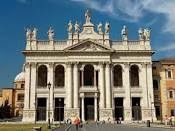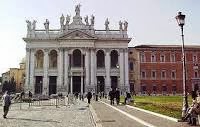
The inscription on the façade of the Basilica of St. John Lateran reads: “The Most Holy Church of the Lateran, Mother and Head of all the Churches of the City and of the World”. This cathedral of Rome owes its origins to the Emperor Constantine in the 4th century and was where the Popes resided until the 14th century when the papacy became centralized at the Vatican.

Last week the focus of our New Testament class was Matthew’s gospel. We visited the Basilica of St. John Lateran and studied some of Matthew’s theological themes contained in its structure, mosaics, statuary, and paintings. Reading the “text” of the basilica the students discovered a salvation history similar to the one in Matthew’s gospel. Along the central nave leading to the main altar are statues of the 12 apostles, over which are base reliefs of alternating scenes from the Old Testament and the New Testament. Above these are oval portaits of the 12 Old Testament prophets. This artistic schema is not only beautiful and impressive, but tells the story of Jesus the Messiah, much as Matthew does with his stress on Old Testament fulfillment. Here are some excerpts from the students’ weekly essays:
“These 12 statues represent the 12 apostles who are the “pillars” of the Church. The scenes above each apostle represent stories from the Old Testament (left) and the New Testament (right). Each story has a mirror effect from the one across from it. These scenes represent Matthew’s ecclesiology that the Church is unrecognizable without the history of Israel.” Kerrie Lynch
“Both the Gospel of Matthew and St. John’s Lateran Basilica work together to stress one of the cardinal aspects of Christianity: the joining of the Old and New Testaments. This form of fulfillment is very apparent in how Jesus Christ not only becomes the full revelation of Christianity but also how he fulfills lessons given in the Old Testament through his ministry on earth.” Scott Blackburn

“We are able to see some of Matthew’s key teachings inside the walls of the Basilica of St. John Lateran. These are the Old Testament support of New Testament figures and happenings, and the importance of the twelve apostles, especially Peter. It is almost as this basilica was built using principles found in Matthew more so than the other Gospels.” Sam Scherer

“Like the Gospel of Matthew which preaches a new story of Jesus, based on older stories from the New Testament, St. Giovanni of Laterano has many scriptural and biblical scenes from both the Old Testament as well as the New Testament… The shift from the stories of the Old Testament to the stories of the New Testament again focus on the switch from Moses as teacher to Jesus as teacher just like Matthew did within his Gospel.” Mike Humphreys

“The central nave of Saint John Lateran embodies the history of salvation within Christianity beginning with oval paintings of the twelve prophets, supported by statues of the twelve apostles, and intertwined by twelve reliefs that show the life of Jesus the Messiah as prefigured in the Old Testament.” Zachary Jensen

“Emperor Constantine built this first Christian basilica in the city with the doors from the Senate building of the Forum, demonstrating a transfer of power from the state to the Church. In this way he shows the power of Christ reigning over the power of the Emperor, worshiping Jesus’ almighty power.” Brianna Fontaine

“The four rivers of paradise are below Jesus Christ, painting the picture of a “watery apse"… This is an illusion of baptism and is evident in the resurrection scene of Matthew 28, as the Emmanuel promises he will be with them until the end, he says teach and commissions the apostles to baptize.” Veronika Abkarian

“The Lateran Baptistery symbolized eternity for the Christians who came to be reborn. The set up of this baptistery is an octagonal structure, this being because the 8th day represents eternity for Christians. It is both a cleansing and rebirth process where the member is able to go from his or her old self to a new life led by Christ.” Victoria Caruso


“8 porphyry columns surround the Baptistery of the Lateran. The 8 sides represent the 8th day for Christians. The 8th day signifies eternity. Baptism is particularly important in Matthew’s gospel … St. John Lateran’s baptistery looks like a tub (cleansing) and tomb (death of old life and birth into new life). It is the womb of the church and gives birth to children…” Paige Lee

Go Friars!
Dr. Aurelie Hagstrom is currently serving as the Providence College Faculty Resident Director for the Providence College & Center for Theology & Religious Studies. You can find the original version of her blog post on the 'Providence College in Rome' blog here: http://blogs.providence.edu/rome/2014/02/13/mother-and-head-of-all-the-churches/







